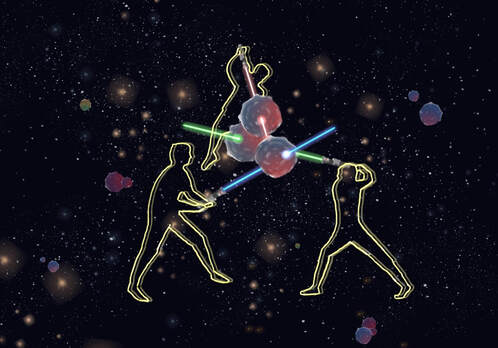|
By Lauren Goralsky Close your eyes. The year is 1977, and you are staring at an oversized movie screen in quiet expectation when the words “Star Wars” appear. Fast forward 2 hours to the end of the film, and you find yourself longing for intergalactic space travel, maybe even slightly melancholy that real lightsabers are not for sale at the local Target. While most of us have accepted the fact that we must go through life without handy and deadly lasers by our side, scientists, like the Jedi, have not given up hope. Scientists are currently using the latest laser technology to fight the ultimate earthly enemy: cancer. In its simplest terms, cancer involves the uncontrollable replication of cells. Under normal conditions, cells grow, divide, and then die, with most living only a few days. Typically, this growth process is strictly regulated with checkpoints that ensure the correct construction of the new cells and that signal mature cells to divide. If even the smallest error occurs in cell replication, the cell can undergo apoptosis: cell suicide. Cancerous cells, on the other hand, continuously replicate without regard for the previously established checkpoints. These mutated cells grow at an exponential rate, creating tumors, and can eventually invade various parts of the body, leading to the body’s deterioration. Since the 1980s, researchers have examined the use of laser therapy to combat the construction of such tumors within the body. When photons of visible light hit our cells, they are absorbed, resulting in the production of heat. Knowing that healthy and damaged cells absorb different wavelengths of light, scientists can use a laser programmed at a certain tumor-specific wavelength to kill tumor cells, minimizing the damage done to surrounding, healthy cells. After an extended period of time, these cells will be irreversibly damaged by exposure to temperatures above 45°C. This means that the mutated, cancerous cells will no longer be able to replicate, slowing or stopping the spread of cancer throughout the body. Additionally, laser beams can be used to activate photosensitizing agents as part of a treatment known as photodynamic therapy. Through entrance to the bloodstream or placement on the skin, photosensitizing agents come into contact with and are absorbed by cancerous cells. These photosensitizing agents are light sensitive and can initiate destructive chemical reactions within the cell. Once a patient is exposed to specific wavelengths of light by a laser beam, the photosensitizing agents are triggered and react to produce a specific type of toxic oxygen molecule, destroying the tumor. This technique of cancer treatment is often highly regarded for the significant benefits it brings to patients. Not only does the use of laser therapy take less time, but it is more precise than surgical removal of tumors and often leads to less medical repercussions as it maintains little contact with other tissues. Overall, laser therapy involves less bleeding and swelling, and in addition, the heat of the laser acts as a sterilizing agent, reducing the risk of infection. Furthermore, the employment of this therapy is often not dependent on hospitalization, yet may be performed in outpatient settings, increasing access for many cancer patients. Unfortunately, the cost and the necessary expertise to perform the treatment often inhibit the broad application of laser therapy. Additionally, the effects of the treatment do not always persist for long periods of time. This means that even after eliminating a significant portion of cancer cells, more can still proliferate, requiring additional laser exposure and producing an expensive and unsustainable cycle. However, this treatment still maintains a promising future as additional research is performed. The association of light and heat with cell death has been applied to emerging treatments such as the use of nanoparticles to target tumors. In order to further increase the precision and effectiveness of laser therapy, researchers have found that through cultivating nanoparticles in the selected tumor, additional light can be absorbed and localized within the tumor. This prevents damage to surrounding cells and further eliminates side effects associated with the treatment of cancer. So as we embody the next generation of inventors, scientists, engineers, and entrepreneurs, we must promote the development of revolutionary care for our fellow human beings. Whether it is expanding on revolutionary cancer treatments or further developing nanoparticles, may the force of science be with you.
0 Comments
Leave a Reply. |
Categories
All
Archives
April 2024
|

